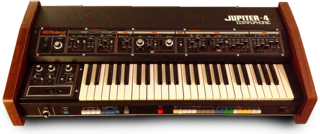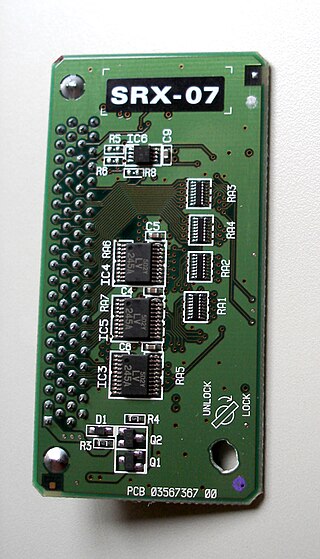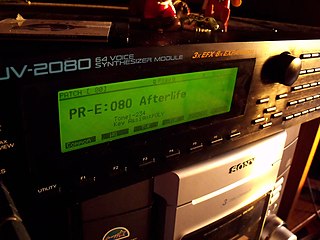
The Korg M1 is a synthesizer and music workstation manufactured by Korg from 1988 to 1995. It is one of the bestselling synthesizers in history, selling an estimated 250,000 units. The M1 was widely used in popular music and stock music in the late 1980s and early 1990s. The piano and organ presets were used in 1990s house music, beginning with Madonna's 1990 single "Vogue".

The Roland D-50 is a synthesizer produced by Roland and released in April of 1987. Its features include digital sample-based subtractive synthesis, on-board effects, a joystick for data manipulation, and an analog synthesis-styled layout design. The external Roland PG-1000 (1987) programmer could also be attached to the D-50 for more complex manipulation of its sounds. It was also produced in a rack-mount variant design, the D-550, with almost 450 user-adjustable parameters.

The Roland MC-303 is the first of a series of musical instruments known as a groovebox. It combines a simple sound module with a sequencer to record and store notation, along with controls aimed at encouraging the musician to improvise the music while it is playing. Despite the number in its name and the attention it received at its launch, the MC-303 has more in common with other MC prefixed synthesizers, which contain built-in sequencers, than it does with the famous Roland TB-303. As the first Groovebox, the MC-303 was the first in a line of inexpensive products specifically targeted towards house DJs and amateur home musicians rather than professional producers. It was superseded by the Roland MC-505. It is the predecessor to the Roland JX-305, Roland D2, Roland MC-307, Roland EG-101, Roland MC-09, Roland MC-909, Roland MC-808, and most recently the Roland MC-707 in 2019, along with its more portable sibling, the Roland MC-101.
A rompler is an electronic musical instrument that plays pre-fabricated sounds based on audio samples. The term rompler is a blend of the terms ROM and sampler. In contrast to samplers, romplers do not record audio. Both may have additional sound editing features, such as layering several waveforms and modulation with ADSR envelopes, filters and LFOs.

The Ensoniq MR61 is a 61-key music workstation synthesizer that Ensoniq released in 1996. It features a 16-track sequencer, digital effects, and several hundred onboard sounds or patches.

The Roland MC-505 is a groovebox conceived in 1998 as a combination of a MIDI controller, a music sequencer, a drum machine, and a desktop synthesizer with many synthesis features: arpeggiator, oscillators, and voltage-controlled filter, control of attack, decay, sustain and release, different envelopes and 2 Lfo. It was released as the successor to the Roland MC-303 and is a compact version of the Roland JX-305 Groovesynth without the full set of 61 keys. It is also the predecessor to the Roland D2, Roland MC-307, Roland MC-909 and the Roland MC-808.

The Roland Jupiter-4 (JP-4) was an analog synthesizer manufactured by the Roland Corporation between 1978 and 1981. It was notable as the company's first self-contained polyphonic synthesizer, and for employing digital control of analog circuits, allowing for such features as programmable memory, voice assignment modes, an arpeggiator, polyphonic portamento and others.

The discontinued Roland MC-909 Sampling Groovebox combines the features of a synthesizer, sequencer, and sampler, with extensive hands-on control of both the sound engine and the sequencing flow. It was intended primarily for live performance of pre-programmed patterns consisting of up to 16 tracks of MIDI data. It was released by Roland Corporation on October 8, 2002. This product was announced at the AES Fall Convention in 2002. It is the direct successor to the Roland MC-505 and is the predecessor to the Roland MC-808. Which eventually ended the "Groovebox by year 2010" line of products by Roland which began in the year 1996 with the Original Roland MC-303 groovebox. The Roland Groovebox began again resurgence in the year 2019 with a two new modern & redesign Roland MC-707 GROOVEBOX/Roland MC-101 GROOVEBOX. The Roland MC-909 was developed from the blueprint of Roland's own "Roland Fantom-S Workstation & Roland Fantom-X Workstation" and uses the same structure and operating system, with some differences regarding the Patterns section, not implemented in the Roland Fantom S/X6/X7/X8 Workstation.

The Roland Sound Canvas lineup is a series of General MIDI (GM) based pulse-code modulation (PCM) sound modules and sound cards, primarily intended for computer music usage, created by Japanese manufacturer Roland Corporation. Some models include a serial or USB connection, to a personal computer.

The Roland XP-30 is a 61-key, 64-voice expandable synthesizer. Released in 1999, it was produced until 2002. Based on the acclaimed mid-90s JV sound engine built around a 32-bit RISC processor, it is considered to be the best value-for-money of all of the Roland JV and XP series synthesizers.
Roland GS, or just GS, sometimes expanded as General Standard or General Sound, is a MIDI specification. It requires that all GS-compatible equipment must meet a certain set of features and it documents interpretations of some MIDI commands and bytes sequences, thus defining instrument tones, controllers for sound effects, etc.

The Korg Wavestation is a vector synthesis synthesizer first produced in the early 1990s and later re-released as a software synthesizer in 2004. Its primary innovation was Wave Sequencing, a method of multi-timbral sound generation in which different PCM waveform data are played successively, resulting in continuously evolving sounds. The Wavestation's "Advanced Vector Synthesis" sound architecture resembled early vector synths such as the Sequential Circuits Prophet VS.

The Roland JD-800 is a digital synthesizer that was manufactured between 1991 and 1996. It features many knobs and sliders for patch editing and performance control — features that some manufacturers, including Roland, had been omitting in the name of streamlining since the inception of the Yamaha DX7. The JD-800 thus became very popular with musicians who wished to take a hands-on approach to patch programming. The introduction in the manual states that Roland's intention with the JD-800 was to "return to the roots of synthesis".

The Roland XP-80 is a music workstation that uses digital PCM subtractive synthesis and combines an updated version of the JV-1080 synthesizer engine with the sequencer capabilities of the Roland MRC-Pro sequencer. The XP-80 was introduced in 1996 and is now discontinued.

The Roland U-20 is a PCM-sample synthesizer, released by Roland in 1989. It was the keyboard version of the U-220 rack module, which was in turn a similar follow-up product to Roland's U-110 rack module of 1988.

The SRX are a series of expansion boards produced by Roland Corporation. First introduced in 2000, they are small boards of electronic circuitry with 64MB ROMs containing patches (timbres) and rhythm sets. They are used to expand certain models of Roland synthesizers, music workstations, keyboards, and sound modules.

The Roland XP-50 is a music workstation that combines the synthesizer engine of Roland's JV-1080 sound module with the sequencing capabilities of their MRC-Pro sequencer and a 61-note keyboard. First released in 1995, the XP-50 and the Roland XP-10 were the first two Roland XP-series products, later joined by the XP-80 and XP-30.
The Roland JD-990 Super JD is an updated version of the Roland JD-800 synthesizer in the form of a module with expanded capabilities, which was released in 1993 by Roland Corporation. JD-990 is a multitimbral synthesizer utilising PCM sample-based synthesis technology. In a sense it is not a true module version of a JD-800 as it has many expanded features and as a result the two are incompatible in exchanging presets. It is equipped with 6 MB of ROM containing sampled PCM waveforms, four sets of stereo outputs that are assignable to individual, internal, instruments, and standard MIDI in/out/through ports. JD-990 has a large LCD display and programming takes place through a keypad on the front panel of the unit. The unit can generate multi-timbral sounds reminiscent of the vintage analogue synthesizers but is also capable of generation of modern digital textures. There are several expansion boards available for JD-990 that can be installed in the provided expansion slot in the chassis of the unit.

The Roland JV-2080 is a rack-mount expandable MIDI sound module and an updated version of the Roland JV-1080. Produced by the Roland Corporation, released in 1996 and built on a sample-based synthesis architecture, the JV-2080 provides a library of on-board sample material and a semi-modular synthesis engine.
The Roland D-70 is a 76 note Super LA synthesizer produced in Japan in 1990. it featured a 240 x 64 pixel backlit LCD display and competed with the likes of the Korg M1 and T-series workstations and Yamaha SY77 workstation, although the D-70 was not itself a workstation because it lacked a sequencer. The D-70 can also split or layer the four tones that constitute a patch and has D-50 style TVF filters. It has onboard drums sounds and is 6-part multi timbral. It has four left control faders that can be assigned in real time to the following paramemeters: Level, Pan, Tuning, Cutoff, Resonance, Attack, and Release. It has three modes of play: Mono, Polyphonic, Split. Despite being anticipated as a "Super D-50", it is in fact a different machine, a prototype of very successful JV series full-sample playback synths (ROMplers). It's very similar to JV-90, though has fewer quality samples and fewer editing capabilities.



















